Explore Khasab - Oman Travel, Asia
Nestled in the rugged beauty of Oman’s Musandam Peninsula, Khasab offers travelers an unforgettable blend of culture, history, and natural wonders. Known as the "Norway of Arabia" due to its stunning fjord-like inlets, Khasab is a sanctuary for adventurers, nature lovers, and history buffs. With crystal-clear waters, towering cliffs, and warm Omani hospitality, this serene destination is perfect for those seeking both relaxation and exploration. Whether it's cruising through the breathtaking Musandam fjords or diving deep into Khasab’s rich cultural history, there’s something for everyone in this coastal paradise.
Population: Approximately 30,000 in 2020.
Economy: Khasab's economy thrives on fishing, tourism, and small-scale trade, with a growing focus on attracting visitors to its natural beauty and cultural heritage, particularly through eco-tourism and maritime activities.
Landmarks: Famous for the Khasab Castle, Musandam Fjords, and the Jebel Harim.
Oman
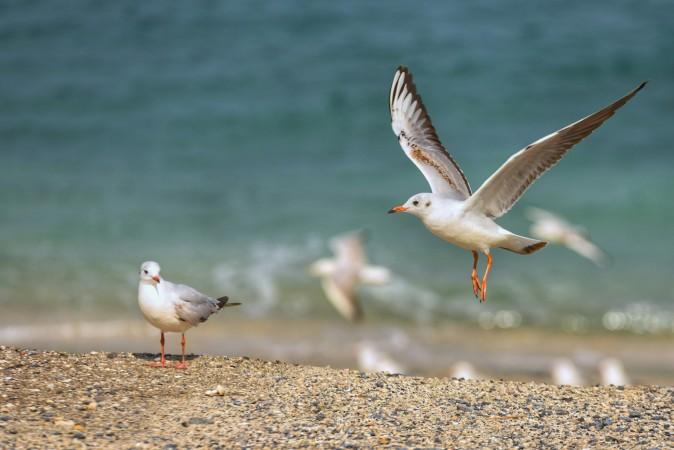
Overview of Khasab
History & Cultural Influence
The city has long served as a strategic point along the Strait of Hormuz, an essential maritime route between the Arabian Gulf and the Indian Ocean. This made Khasab a bustling port in ancient times, where traders and explorers around the world exchanged goods and ideas. However, Khasab's culture is profoundly ingrained in Omani traditions and Islamic rituals. The influence of the Bedouin lifestyle, evident in the nomadic tribes that once roamed the mountains and deserts, still permeates the region’s identity today. Visitors can explore ancient villages and witness how traditional ways of life have blended with modernity.
Interaction with the Locals
Khasab, the capital of the Musandam Peninsula in Oman, has a relatively small population with the majority being the Omani and a mix of local tribes. Many residents have careers in fishing, agriculture, and tourism. Known for their warm hospitality, Khasab's residents are proud of their heritage, with strong connections to both the sea and the mountains, and they welcome visitors with open arms, often inviting them to experience their way of life firsthand.
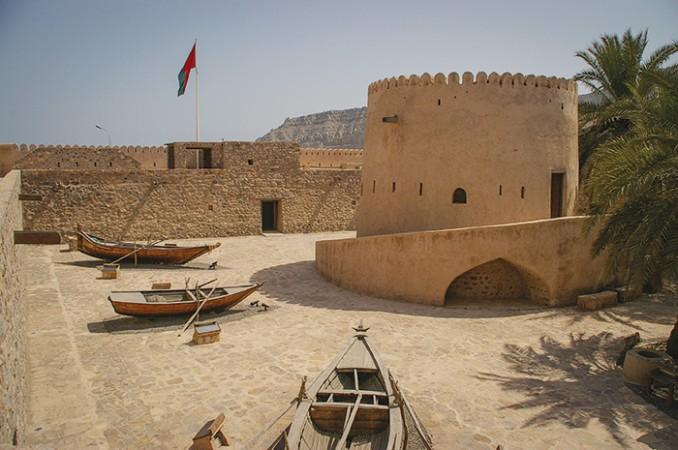
Khasab Castle - © Times of Oman
Top Attractions in Khasab
Khasab Castle
One of Khasab’s most notable landmarks, Khasab Castle, is a symbol of the city’s resilience and strategic importance. Visitors can explore its towers and courtyards, where exhibits of traditional Omani crafts and artifacts offer a fascinating insight into life in ancient Musandam. The castle’s location, surrounded by mountains and overlooking the sea, adds to its majestic charm.
Musandam Fjords
Khasab is famous for its Musandam Fjords, a network of deep, narrow inlets surrounded by dramatic cliffs. Often called the “Norway of Arabia,” these fjords are best explored by dhow cruises, which offer a serene way to view the coastline and spot wildlife like dolphins. The turquoise waters are ideal for snorkeling and diving, revealing vibrant coral reefs and colorful marine life beneath the surface.
Jebel Harim
For adventure seekers, a trip to Jebel Harim (Mountain of Women) is a must. This is the highest peak in Musandam, offering breathtaking panoramic views of the surrounding landscapes. Visitors can take part in off-road safaris that traverse winding mountain paths, passing by ancient petroglyphs and remote villages. The journey to Jebel Harim is as thrilling as the destination, making it a favorite for nature enthusiasts and hikers alike.
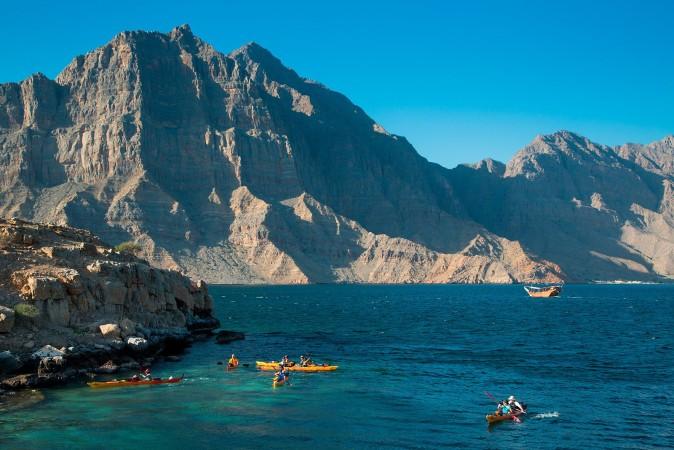
Musandam Fjords - © CNN
Must-Try Dishes in Khasab
Omani cuisine in Khasab reflects the region’s deep connection to the sea and its centuries-old traditions. Visitors will find a variety of hearty, flavorful dishes that showcase the unique spices and ingredients of the Arabian Peninsula.
- Shuwa: A traditional Omani dish, Shuwa is made by marinating lamb in a blend of spices and cooking it slowly in an underground sand oven for up to 48 hours, resulting in a tender, flavorful meat that falls off the bone.
- Majboos: Often compared to biryani, Majboos is a spiced rice dish commonly served with chicken, lamb, or fish. The saffron-infused rice is seasoned with a blend of cardamom, cinnamon, and dried lime, giving it a distinct flavor.
- Harees: A popular dish during Ramadan and festivals, Harees is a simple yet delicious porridge made from wheat and meat, cooked to a smooth consistency. It's a comforting dish that showcases Omani culinary traditions.
- Seafood Dishes: Due to its seaside location, Khasab's cuisine is heavily influenced by seafood. From freshly caught grilled kingfish to Samak Mashwi (spiced grilled fish), you’ll find an array of seafood options prepared with regional spices and cooking methods.
- Dates and Omani Coffee (Kahwa): No visit to Khasab is complete without trying Omani dates, often enjoyed with Kahwa, a lightly spiced coffee flavored with cardamom. It’s a traditional offering of hospitality that locals proudly share with guests.

Chicken Majboos - © The Captain Chef
Festivals & Local Celebrations
Khasab is a town deeply connected to its cultural roots, and its festivals are a reflection of Oman’s rich heritage and Islamic traditions. Travelers who visit during local celebrations will experience the region’s warmth, unity, and joy.
Eid al-Fitr & Eid al-Adha
These major Islamic holidays are celebrated with great enthusiasm in Khasab. Eid al-Fitr celebrates the conclusion of Ramadan, the Islamic holy month of fasting, and Eid al-Adha remembers Ibrahim (Abraham)'s willingness to sacrifice his son. During these celebrations, locals gather for prayers, share festive meals with family and friends, and partake in various community events. Visitors are often welcomed to join in these celebrations, experiencing the strong sense of community and tradition.
Oman National Day
Celebrated on November 18th, Oman National Day is a time of patriotic pride throughout the country, including in Khasab. This day honors Sultan Qaboos' birth, who founded modern Oman. Locals celebrate with parades, fireworks, cultural performances, and traditional dances. It's a perfect opportunity for visitors to immerse themselves in the vibrant Omani culture and witness the national pride of the people.

Oman National Day celebration - © Edarabia
What to Do in Khasab
- Dhow Cruises: A dhow cruise through the Musandam Fjords is one of the most popular activities in Khasab. These traditional wooden boats glide along the serene waters, surrounded by towering cliffs. During the cruise, you can spot playful dolphins, explore remote islands, and snorkel in crystal-clear waters.
- Mountain Safaris: For those looking for adventure, an off-road safari to Jebel Harim is an exhilarating way to explore the rugged mountains of Musandam. You’ll travel through winding mountain roads, passing by traditional Omani villages and ancient petroglyphs.
- Snorkeling and Scuba Diving: Khasab’s clear waters and diverse marine life make it a paradise for snorkeling and scuba diving enthusiasts. Popular snorkeling spots include Telegraph Island and the many hidden coves along the fjords.
- Hiking and Trekking: With its dramatic mountain ranges and scenic coastal trails, Khasab is a hiker’s dream. There are several hiking routes that offer varying levels of difficulty, with breathtaking views and the chance to discover isolated villages and historical landmarks along the way.
Shopping in Khasab
- Local Souks: The souks (markets) in Khasab are a treasure trove of traditional Omani goods. You’ll find beautifully crafted silver jewelry, pottery, and woven baskets, all reflecting the region’s rich artisanal heritage. The souks are a great place to practice your bargaining skills while interacting with the friendly local vendors.
- Date and Spice Markets: Oman is known for its delicious dates, and Khasab is no exception. The local date markets offer a variety of these sweet treats, often packaged in decorative boxes that make perfect gifts. Additionally, the spice markets are filled with the scents of exotic spices like saffron, frankincense, and cardamom—essential ingredients in Omani cuisine.
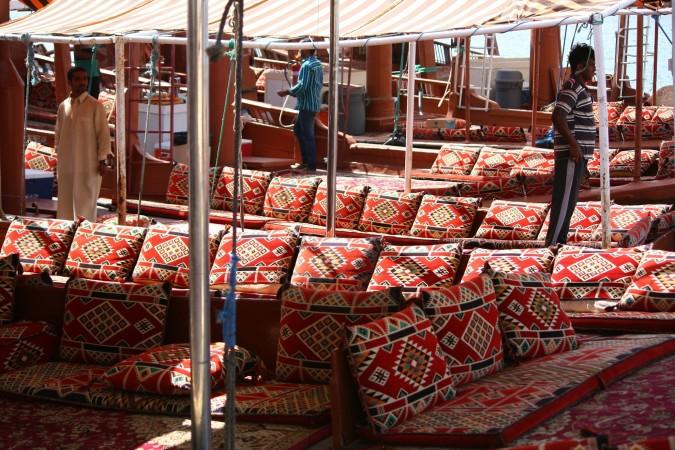
Khasab souk's textile products- © Iwona Castiello d'Antonio
Weather in Khasab: Best Time to Visit
Khasab experiences a typical desert climate with distinct seasons that affect the best time for travel. Knowing when to visit can make your experience more enjoyable, especially if you're planning outdoor activities like hiking, dhow cruises, or sightseeing.
Spring in Khasab
Spring offers warmer temperatures, ranging between 22°C and 35°C (72°F to 95°F), but it's still a good time to visit, especially in early spring. Outdoor activities are still possible, although the rising temperatures may make midday excursions less comfortable. Mornings and evenings remain cool enough for exploring Khasab’s natural beauty.
Summer in Khasab
Summer in Khasab is extremely hot and humid, with temperatures often exceeding 40°C (104°F). Outdoor activities are generally not recommended due to the intense heat. If you’re visiting during this season, it's best to focus on indoor attractions like Khasab Castle or enjoy the cooler early mornings and evenings. Travelers during summer should prioritize staying hydrated and wearing sun protection.
Autumn in Khasab
Autumn represents the transition from summer to cooler months and is a popular season to visit. Temperatures range from 25°C to 35°C (77°F to 95°F), offering more tolerable heat as the region moves into the winter season. This is also an excellent time to experience outdoor activities before the tourist crowds arrive.
Winter in Khasab
This is the peak tourist season in Khasab, with pleasant temperatures ranging from 16°C to 25°C (61°F to 77°F). The weather is cool, making it ideal for outdoor adventures and exploration. This is the best time to enjoy activities like snorkeling in the fjords or taking a scenic mountain safari. Clear skies and mild conditions make winter the most recommended season for visiting.
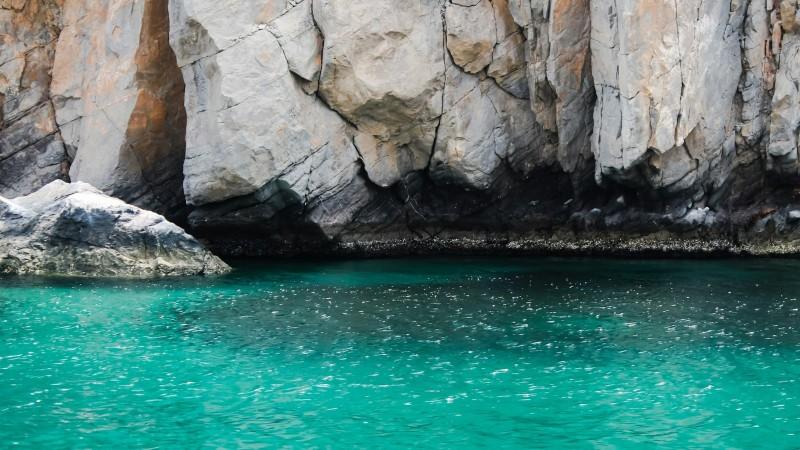
Experience the natural beauty of Khasab - © Vivek Lad
Essential Travel Information
Getting Around Khasab
- Taxis: Taxis are readily available in Khasab and are a convenient way to travel short distances, such as from the airport to your hotel or to nearby attractions. Be sure to agree on the fare before starting your trip, as taxis may not always use meters.
- Car Rentals: Renting a car is a great option for travelers who want flexibility and independence in exploring the region. Rental cars are available in Khasab, and having your own vehicle allows you to easily visit more remote areas like Jebel Harim or drive along the scenic coastal roads. A 4x4 is recommended for off-road adventures.
- Ferries and Boats: Dhow cruises and ferry services are popular ways to explore Khasab’s Musandam Fjords. These boats can also be used to reach isolated villages and islands that are only accessible by sea. This is a unique way to see Khasab’s natural beauty up close.
ATM & Banking Services
In Khasab, travelers will find convenient access to ATM and banking services, particularly in the town center and tourist areas. Most ATMs accept international debit and credit cards, making it easy to withdraw cash in the local currency, Omani Rials (OMR). While larger establishments, such as hotels and restaurants, often accept card payments, it's recommended to carry cash for smaller purchases, local markets, and taxis, as cash is preferred in many places.
Where to Stay in Khasab
- Luxury Resorts: For travelers seeking a more indulgent stay, Khasab has upscale resorts that offer stunning views of the Musandam coastline, along with premium amenities such as swimming pools, fine dining, and spa services. These resorts provide a relaxing atmosphere with spacious rooms and easy access to major attractions.
- Mid-range Hotels: These accommodations typically offer modern amenities such as air-conditioned rooms, on-site dining, and family-friendly services, all at reasonable rates. These hotels are well-suited for families, groups, or solo travelers who want a comfortable base to explore the area.
- Camping: For the adventurous, camping is an option in Khasab, particularly in the Musandam Fjords or near the mountains. Some tour operators offer guided camping experiences, where you can enjoy sleeping under the stars in one of Oman’s most remote and beautiful locations.
Des articles pour vous

Voyage à Kampong Cham - Cambodge, Asie
Kampong Cham est une charmante ville riveraine située le long du fleuve Mékong. Connue pour son importance historique et ses attractions culturelles, Kampong Cham offre un mélange d'architecture coloniale, de temples anciens et de paysages pittoresques. Kampong Cham est reliée au district voisin de Tbong Khmum par le pont Kizuna, le premier pont au Cambodge à traverser le fleuve Mékong, en faisant un carrefour de transport crucial pour la région.
Population : Estimation de 80 000 habitants (en 2024)
Économie : Bien que n'étant pas encore une destination touristique majeure, Kampong Cham propose des sites culturels et historiques, tels que le temple Wat Nokor et le pont en bambou de Koh Pen, ainsi que des attractions naturelles comme des forêts et des chutes d'eau. Le gouvernement se concentre sur le développement du tourisme pour améliorer l'économie locale.
Points d'intérêt : Wat Nokor Bachey, Phnom Han Chey, Phnom Pros et Phnom Srey, pont en bambou de Koh Pen, Wat Joy T'maw, Preah Theat Teuk Chha, piste d'atterrissage abandonnée de l'US.

Explorez Nha Trang - Voyage au centre du Vietnam, Asie
Nichée le long de la magnifique côte du Vietnam, Nha Trang se distingue comme une destination de premier choix pour les voyageurs. Cette ville côtière, réputée pour ses superbes plages et sa vie marine foisonnante, s'adresse à tous. Nha Trang vous accueille à bras ouverts, que vous recherchiez des aventures, de la culture ou de la détente au bord de la mer. Ce guide vous fera découvrir les points forts de cet endroit magnifique, facilitant ainsi la planification de votre voyage de manière fluide et excitante.
Population : Environ 423 000 habitants en 2019.
Économie : L'un des principaux centres touristiques du Vietnam et la plus grande économie de la province de Khanh Hoa.
Sites emblématiques : Célèbre pour les tours Cham de Po Nagar, la cathédrale de Nha Trang et l'île Hon Mun.

Voyage à Sihanoukville - Cambodge, Asie
Sihanoukville, une ville côtière du sud-ouest du Cambodge, est la capitale de la province de Preah Sihanouk. Située sur une péninsule le long du golfe de Thaïlande, la ville est bien reliée à Phnom Penh par des autoroutes principales et dispose d'un aéroport international.
La ville abrite le seul port en eau profonde du Cambodge, jouant un rôle crucial dans la logistique et le commerce du pays. Les plages magnifiques de Sihanoukville, telles qu'Ochheuteal et Serendipity, attirent aussi bien les touristes nationaux qu'internationaux. Le développement économique a prospéré ces dernières années, en particulier grâce à la création de la Zone économique spéciale de Sihanoukville (SSEZ) et aux investissements chinois dans les casinos, l'immobilier et les stations balnéaires. La ville offre également des attractions naturelles telles que le parc national de Ream et plusieurs îles voisines, en faisant une destination variée pour les voyageurs d'affaires et de loisirs.
Population : La population de Sihanoukville était d'environ 160 000 habitants en 2024.
Économie : Sihanoukville, une ville côtière en pleine croissance au Cambodge, se distingue par son mélange dynamique de développement économique et de tourisme. La Zone économique spéciale de Sihanoukville (SSEZ) est devenue un pôle industriel majeur, abritant plus de 180 entreprises et créant des milliers d'emplois. Avec le seul port en eau profonde du Cambodge, la ville joue un rôle clé dans le commerce et la logistique du pays. Bien qu'elle se soit transformée d'une petite ville balnéaire tranquille en un centre urbain animé, Sihanoukville reste célèbre pour ses plages immaculées, attirant des touristes tout au long de l'année. Les investissements chinois importants ont alimenté la croissance des hôtels, des casinos et de l'immobilier, faisant de la ville un centre d'opportunités économiques et d'hospitalité.
Monuments : Plage d'Otres, Plage d'Ochheuteal, Plage de l'Indépendance, Parc national de Ream, Chute d'eau de Kbal Chhay, Monument des Lions d'Or, Wat Leu.

Explorez Kharkhorin - Voyage en Mongolie, Asie
Bienvenue à Kharkhorin, un trésor historique niché au cœur de la Mongolie. Ancienne capitale vibrante de l'Empire Mongol sous le légendaire Gengis Khan, Kharkhorin se dresse comme un témoignage de la riche culture et de l'histoire de la Mongolie. Cette ville antique possède une combinaison unique d'importance historique et de paysages époustouflants, en faisant une destination incontournable pour un voyage de rêve en Mongolie. En mettant le pied à Kharkhorin, vous ferez un saut dans le temps, à une époque de grands palais, de routes commerciales prospères et d'échanges culturels sans pareils. Que vous soyez intrigué par les ruines anciennes, désireux d'explorer les traditions locales ou simplement en quête d'une immersion dans la beauté naturelle de la Mongolie, Kharkhorin a quelque chose à offrir à chacun.
Population : Environ 1 000 habitants en 2020.
Économie : L'une des attractions touristiques les plus importantes de la Mongolie et l'ancienne capitale de l'Empire Mongol.
Monuments : Célèbre pour les Ruines de Kharkhorin, le Monastère d'Erdene Zuu, et la Vallée d'Orkhon, un site du patrimoine mondial de l'UNESCO.

Explore Luang Prabang - Laos Travel, Asia
Luang Prabang, nestled in northern Laos at the meeting point of the Mekong river and Nam Khan river, is a city celebrated for its rich cultural heritage and stunning natural beauty. Recognized as a UNESCO World Heritage Site in 1995, it boasts a unique blend of traditional Lao and French architecture that has been carefully preserved. Whether you're wandering through its ancient temples, admiring the local architecture, or soaking in the natural beauty of waterfalls and rivers, Luang Prabang offers something for everyone.
Population: Approximately 470,000 in 2020.
Economy: Luang Prabang's economy thrives on tourism, with its UNESCO status drawing visitors to its temples, natural wonders, and cultural experiences. Local crafts, hospitality, and small businesses also play vital roles, supporting the town's sustainable growth. Local crafts, hospitality, and small businesses also play vital roles, supporting the town's sustainable growth.
Landmarks: Famous for the Wat Xieng Thong, Royal Palace Museum (also known as Haw Kham), and Mount Phousi (Phou Si Hill).Luang Prabang, nestled in northern Laos at the meeting point of the Mekong river and Nam Khan river, is a city celebrated for its rich cultural heritage and stunning natural beauty. Recognized as a UNESCO World Heritage Site in 1995, it boasts a unique blend of traditional Lao and French architecture that has been carefully preserved. Whether you're wandering through its ancient temples, admiring the local architecture, or soaking in the natural beauty of waterfalls and rivers, Luang Prabang offers something for everyone.
Population: Approximately 470,000 in 2020.
Economy: Luang Prabang's economy thrives on tourism, with its UNESCO status drawing visitors to its temples, natural wonders, and cultural experiences. Local crafts, hospitality, and small businesses also play vital roles, supporting the town's sustainable growth. Local crafts, hospitality, and small businesses also play vital roles, supporting the town's sustainable growth.
Landmarks: Famous for the Wat Xieng Thong, Royal Palace Museum (also known as Haw Kham), and Mount Phousi (Phou Si Hill).

Explore Vientiane - Laos Travel, Asia
Vientiane, the capital of Laos, offers a unique travel experience for those looking to explore a peaceful Southeast Asian city with a deep connection to its cultural roots. Unlike other bustling capitals, Vientiane boasts a serene and laid-back atmosphere, making it a perfect destination for travelers wanting to escape the chaos of more crowded cities. This charming city sits along the Mekong River, offering scenic views, rich history, and a vibrant yet tranquil way of life. As a gateway to exploring Laos, this capital invites you to slow down, immerse in its heritage, and enjoy the local flavors.
Population: Approximately 840,000 in 2023.
Economy: Vientiane's economy is growing steadily, driven by government services, trade, and tourism. Key sectors include agriculture, manufacturing, and construction. The city's strategic location along the Mekong River supports trade with neighboring Thailand and Vietnam.
Landmarks: Famous for the Pha That Luang, Patuxai, and the Buddha Park (or Wat Xieng Khuan).
